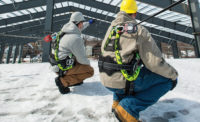Can you carry on this winter?
Prep your facility for these four seasonal hazards

It’s ideal to stay ready for the unexpected, especially when it comes to ornery winter weather. You will feel much more at ease if you transform those anxious feelings of anticipation into proactive preparation.
A survey of small business owners conducted by Travelers Insurance discovered that 44 percent of small businesses in the U.S. don’t have a written business continuity plan or any related document to explain how their business will operate in the event of serious weather emergencies. Regardless of the size of your workplace, consider these four common winter hazards and what you can do to protect your employees and keep your facility running smoothly:
Hazard #1: Poor visibility
Poor visibility due to rain, fog, clouds, and snow drastically hinders orientation, especially when on the road. Bring attention to concealed dangers and communicate safety instructions using strategic visual communication like barricades, cones, floor signs, and labels and signs. Weather can also cause a secondary effect to dampen visibility through power outages. To combat this, apply reflective stick-ons and glow-in-the-dark tape to items and areas that are difficult to identify surrounding your facility, including fire hydrants, machinery, doorways, stairs, etc.
Also, be mindful of debris that could be near major entrances and exit points of your facility that could present hazards. Put a plan in place to regularly clear obstructions and debris that may be harder to see in low-light areas to prevent accidents.
Hazard #2: Slips, trips, and falls
The number one most reported workers’ compensation injury in the winter is from slipping and falling on ice; it is also the cause of nearly 15 percent of all accidental deaths. OSHA in November, 2016 issued an updated General Industry Walking-Working Surfaces and Fall Protection standard that requires employers to offer better protection to their workers that includes falls from walking surfaces and general slip and trip hazards (subpart D). The rule became effective January 17, 2017.Here’s what we recommend you do:
Safeguard your facility from slip, trip, and falls by identifying hazards before they emerge by performing a Job Hazard Analysis (JHA). Do a walk-through of your facility to determine if normal procedures and tasks need to be modified in certain work areas due to the change in weather and temperature. It’s crucial to engage with employees during this process to minimize oversights. You can clearly communicate new changes in procedures and potential hazards by posting temporary signage as reminders.
Keep main pathways and work areas clear of obstacles to reduce the chances of an accident. Provide extra traction using coarse and abrasive tapes in areas that are prone to get slick, like facility loading docks, ramps, stairs, handrails, and uneven surfaces. To combat the elements head-on, apply ice-melting salt, floor mats, and area rugs at exterior entrances to prevent slips.
Hazard #3: Electrical
Common winter mishaps like power outages and blackouts may require evacuation. Outfit your facility with glow-in-the-dark tape and reflective signage to highlight pathways and hard-to-see hazards to safely guide employees away from danger and out to safety. If you have a generator, be sure the main circuit breaker is off and locked out before restarting the generator to protect workers from the risk of undetected backfeed of electrical energy and electrocution. Less obvious electrical hazards can invade via the soles of employee’s shoes. Melted snow or ice that gets brought into your facility can seep into electrical circuits and machinery to cause permanent damage.
Easily and clearly communicate locations of battery and storage stations, high voltage equipment, shut-offs, clearances, and other electrical-related hazards and procedures using premade electrical labels and signs. Additionally, ask workers to wipe their feet before coming inside the building.
Hazard #4: Facility damage from the elements
Minimize the chances of developing maintenance problems and structural damage by preparing your facility for the change in elements ahead of time. Protect valuable equipment, machinery, and materials by making sure you follow these essential steps:
- Implement a business continuity plan: Have a plan that addresses how to protect your building and equipment if a threatening event occurs. Identify threats and risks, analyze the impact, implement controls for prevention and mitigation, and test and improve your plan regularly.
- Protect your roof: Inspect your roof and check your building codes and design criteria to determine preventive actions that are needed to prevent a future collapse. You can minimize the chances of a roof collapse by implementing a snow removal plan.
- Inspect pipes: Prevent pipe bursts and leaks by conducting regular inspections of pipes and plumbing joints. Ensure to mark pipes to clearly communicate their contents and potential hazards to employees in case of an emergency. Ensure pipes and water tanks are insulated to prevent freezing and bursting. Make sure employees know where the shut-off valve is located and a plan is in place if there is an escape of contents.
- Improve organization: Be ready to quickly react and mitigate hazards like unexpected spills with safety equipment nearby, such as spill control kits, first aid kits, and more. In general, communicate the importance of keeping an organized workplace free of unnecessary items and obstacles to reduce the chances of preventable accidents.
Invest in winter safety to prevent losses and enhance safety awareness to protect your workers and facility. Employees need to understand how to work safely when seasonal threats approach, which is why keeping clear and consistent communication with employees about procedures is crucial to ensure overall safety. When there is group awareness, there’s a better chance of success when the time comes to carry out emergency procedures. Be prepared for when winter attempts to wreak havoc on your workplace.
Looking for a reprint of this article?
From high-res PDFs to custom plaques, order your copy today!






